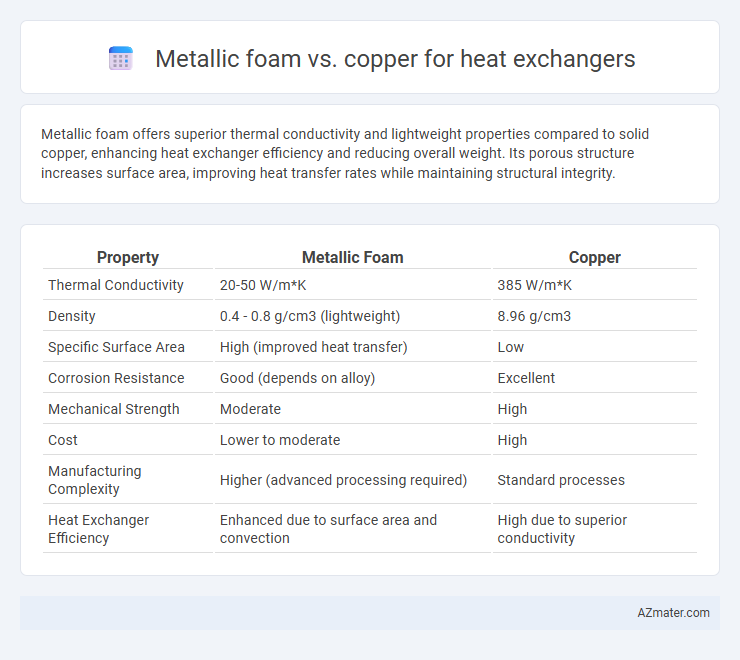Metallic foam offers superior thermal conductivity and lightweight properties compared to solid copper, enhancing heat exchanger efficiency and reducing overall weight. Its porous structure increases surface area, improving heat transfer rates while maintaining structural integrity.
Table of Comparison
| Property | Metallic Foam | Copper |
|---|---|---|
| Thermal Conductivity | 20-50 W/m*K | 385 W/m*K |
| Density | 0.4 - 0.8 g/cm3 (lightweight) | 8.96 g/cm3 |
| Specific Surface Area | High (improved heat transfer) | Low |
| Corrosion Resistance | Good (depends on alloy) | Excellent |
| Mechanical Strength | Moderate | High |
| Cost | Lower to moderate | High |
| Manufacturing Complexity | Higher (advanced processing required) | Standard processes |
| Heat Exchanger Efficiency | Enhanced due to surface area and convection | High due to superior conductivity |
Introduction to Heat Exchanger Materials
Metallic foam and copper are prominent materials in heat exchanger design, each offering distinct advantages for thermal management. Metallic foam provides a high surface area-to-volume ratio and enhanced turbulence, leading to improved heat transfer efficiency and reduced weight. Copper remains a preferred choice due to its exceptional thermal conductivity, corrosion resistance, and ease of fabrication, making it ideal for traditional heat exchanger applications.
Overview of Metallic Foams
Metallic foams, characterized by their low density and high surface area, provide exceptional thermal conductivity and enhanced heat transfer efficiency in heat exchangers compared to solid copper. The porous structure of metallic foams facilitates superior fluid flow, reduces weight, and improves pressure drop performance while maintaining adequate mechanical strength. These attributes make metallic foams a promising alternative to traditional copper, especially in applications demanding lightweight, corrosion-resistant, and thermally efficient heat exchanger materials.
Properties of Copper in Heat Exchangers
Copper exhibits exceptional thermal conductivity, typically around 400 W/m*K, which significantly enhances heat transfer efficiency in heat exchangers. Its excellent corrosion resistance and antimicrobial properties contribute to long-term durability and hygiene, making it ideal for demanding industrial and HVAC applications. Additionally, copper's malleability allows for intricate designs and reliable joint formations, optimizing the overall performance and lifespan of heat exchanger components.
Thermal Conductivity: Metallic Foam vs Copper
Metallic foam demonstrates significantly lower thermal conductivity compared to copper, typically ranging between 10 to 50 W/m*K versus copper's high thermal conductivity of approximately 400 W/m*K. Despite lower conductivity, metallic foams offer enhanced heat transfer efficiency due to increased surface area and convection effects within their porous structure. Copper remains superior for applications requiring rapid heat conduction, while metallic foam is preferred when weight reduction and enhanced fluid interaction are critical.
Weight and Density Comparison
Metallic foam exhibits significantly lower density, typically ranging from 0.1 to 0.6 g/cm3, compared to solid copper's density of approximately 8.96 g/cm3, resulting in a much lighter heat exchanger component. This weight reduction enhances overall system efficiency and facilitates easier handling and installation in applications requiring lightweight materials. The porous structure of metallic foam also provides a favorable strength-to-weight ratio while maintaining effective thermal conductivity for heat exchanger performance.
Corrosion Resistance and Durability
Metallic foam exhibits superior corrosion resistance compared to copper in heat exchanger applications due to its enhanced surface area and ability to form protective oxide layers, which prolongs its lifespan under aggressive conditions. Copper, while highly conductive, is prone to corrosion in certain environments, such as those containing ammonia or acidic compounds, which can reduce its durability and increase maintenance needs. The porous structure of metallic foam not only improves heat transfer efficiency but also offers better resistance to mechanical wear and chemical degradation, resulting in longer service life and reduced replacement costs in heat exchange systems.
Manufacturing and Cost Implications
Metallic foam offers a unique combination of lightweight construction and high surface area, facilitating efficient heat transfer in heat exchangers while supporting cost-effective manufacturing through additive processes like powder metallurgy and investment casting. Copper, known for its superior thermal conductivity, generally incurs higher material and machining costs due to its density and work-hardening characteristics, impacting overall production expenses. Choice between metallic foam and copper hinges on balancing manufacturing complexity against thermal performance, with metallic foam often providing cost advantages in large-scale or geometrically complex heat exchanger designs.
Performance in High-Temperature Applications
Metallic foam offers superior heat transfer performance in high-temperature applications due to its high surface area-to-volume ratio and excellent thermal conductivity, enhancing fluid mixing and turbulence. Copper, with exceptional intrinsic thermal conductivity of approximately 400 W/m*K, provides efficient heat conduction but may be limited by weight and structural rigidity compared to lightweight metallic foams. In extreme temperature environments exceeding 600degC, metallic foam structures composed of high-temperature alloys maintain mechanical integrity and consistent heat exchange efficiency better than pure copper, which softens and oxidizes under prolonged exposure.
Environmental Impact and Sustainability
Metallic foam heat exchangers offer enhanced thermal efficiency and reduced material usage compared to traditional solid copper, leading to lower energy consumption during operation and manufacturing. The porous structure of metallic foam promotes effective heat transfer while enabling weight reduction, contributing to decreased carbon emissions over the product lifecycle. Copper, while highly conductive and recyclable, requires intensive mining and refining processes that pose greater environmental challenges and resource depletion concerns.
Choosing the Right Material for Optimal Heat Exchanger Efficiency
Metallic foam offers superior heat transfer efficiency in heat exchangers due to its high surface area and enhanced turbulence, significantly improving thermal conductivity compared to solid copper. Copper, while possessing excellent intrinsic thermal conductivity, lacks the porous structure of metallic foam, resulting in lower convective heat transfer performance. Selecting metallic foam over copper can optimize heat exchanger efficiency by maximizing heat exchange rates and reducing material weight and volume.

Infographic: Metallic foam vs Copper for Heat exchanger
 azmater.com
azmater.com